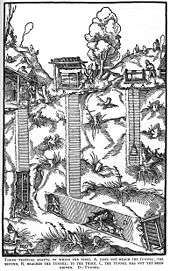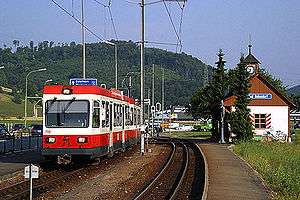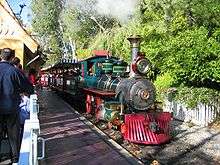Narrow-gauge railway
A narrow-gauge railway (narrow-gauge railroad in the US) is a railway with a track gauge narrower than standard 1,435 mm (4 ft 8 1⁄2 in). Most narrow-gauge railways are between 600 mm (1 ft 11 5⁄8 in) and 1,067 mm (3 ft 6 in).
| Track gauge | ||||||||||||||||||||||||||||||||||||||||||||||||||||||||||||||||||||||||||||||||||||||||
|---|---|---|---|---|---|---|---|---|---|---|---|---|---|---|---|---|---|---|---|---|---|---|---|---|---|---|---|---|---|---|---|---|---|---|---|---|---|---|---|---|---|---|---|---|---|---|---|---|---|---|---|---|---|---|---|---|---|---|---|---|---|---|---|---|---|---|---|---|---|---|---|---|---|---|---|---|---|---|---|---|---|---|---|---|---|---|---|---|
| By transport mode | ||||||||||||||||||||||||||||||||||||||||||||||||||||||||||||||||||||||||||||||||||||||||
|
Tram · Rapid transit Miniature · Scale model |
||||||||||||||||||||||||||||||||||||||||||||||||||||||||||||||||||||||||||||||||||||||||
| By size (list) | ||||||||||||||||||||||||||||||||||||||||||||||||||||||||||||||||||||||||||||||||||||||||
|
||||||||||||||||||||||||||||||||||||||||||||||||||||||||||||||||||||||||||||||||||||||||
| Change of gauge | ||||||||||||||||||||||||||||||||||||||||||||||||||||||||||||||||||||||||||||||||||||||||
|
Break-of-gauge · Dual gauge · Conversion (list) · Bogie exchange · Variable gauge |
||||||||||||||||||||||||||||||||||||||||||||||||||||||||||||||||||||||||||||||||||||||||
| By location | ||||||||||||||||||||||||||||||||||||||||||||||||||||||||||||||||||||||||||||||||||||||||
|
North America · South America · Europe · Australia  |
||||||||||||||||||||||||||||||||||||||||||||||||||||||||||||||||||||||||||||||||||||||||
Since narrow-gauge railways are usually built with tighter curves, smaller structure gauges, and lighter rails, they can be less costly to build, equip, and operate than standard- or broad-gauge railways (particularly in mountainous or difficult terrain). Lower-cost narrow-gauge railways are often built to serve industries and communities where the traffic potential would not justify the cost of a standard- or broad-gauge line. Narrow-gauge railways have specialized use in mines and other environments where a small structure gauge necessitates a small loading gauge. They also have more general applications. Non-industrial, narrow-gauge mountain railways are (or were) common in the Rocky Mountains of the United States and the Pacific Cordillera of Canada, Mexico, Switzerland, Bulgaria, the former Yugoslavia, Greece, and Costa Rica.
In some countries, narrow gauge is the standard; Japan, Indonesia, Taiwan, New Zealand, South Africa, and the Australian states of Queensland, Western Australia and Tasmania have a 3 ft 6 in (1,067 mm) gauge, and Malaysia and Thailand have metre-gauge railways. Narrow-gauge trams, particularly metre-gauge, are common in Europe.
Nomenclature
A narrow-gauge railway is one where the distance between the inside edges of the rails is less than 1,435 mm (4 ft 8 1⁄2 in).[1] Historically, the term was sometimes used to refer to standard-gauge railways, to distinguish them from broad-gauge railways, but this use no longer applies.
History
Early hand-worked lines


The earliest recorded railway appears in Georgius Agricola's 1556 De re metallica, which shows a mine in Bohemia with a railway of about 2 ft (610 mm) gauge. During the 16th century, railways were primarily restricted to hand-pushed, narrow-gauge lines in mines throughout Europe. In the 17th century, mine railways were extended to provide transportation above ground. These lines were industrial, connecting mines with nearby transportation points (usually canals or other waterways). These railways were usually built to the same narrow gauge as the mine railways from which they developed.[2]
Introduction of steam
The world's first steam locomotive, built in 1802 by Richard Trevithick for the Coalbrookdale Company, ran on a 3 ft (914 mm) plateway. The first commercially successful steam locomotive was Matthew Murray's Salamanca built in 1812 for the 4 ft 1 in (1,245 mm) Middleton Railway in Leeds. Salamanca was also the first rack-and-pinion locomotive. During the 1820s and 1830s, a number of industrial narrow-gauge railways in the United Kingdom used steam locomotives. In 1842, the first narrow-gauge steam locomotive outside the UK was built for the 1,100 mm (3 ft 7 5⁄16 in)-gauge Antwerp-Ghent Railway [3] in Belgium. The first use of steam locomotives on a public, passenger-carrying narrow-gauge railway was in 1865, when the Ffestiniog Railway introduced passenger service after receiving its first locomotives two years earlier.[4]
Industrial use
Many narrow-gauge railways were part of industrial enterprises and served primarily as industrial railways, rather than general carriers. Common uses for these industrial narrow-gauge railways included mining, logging, construction, tunnelling, quarrying, and conveying agricultural products. Extensive narrow-gauge networks were constructed in many parts of the world; 19th-century mountain logging operations often used narrow-gauge railways to transport logs from mill to market. Significant sugarcane railways still operate in Cuba, Fiji, Java, the Philippines, and Queensland, and narrow-gauge railway equipment remains in common use for building tunnels.
Internal-combustion locomotives
The first use of an internal combustion engine to power a narrow-gauge locomotive was in 1902. F. C. Blake built a 7 hp petrol locomotive for the Richmond Main Sewerage Board sewage plant at Mortlake. This 2 ft 9 in (838 mm) gauge locomotive was probably the third petrol-engined locomotive built.[5]
First World War and later
Extensive narrow-gauge rail systems served the front-line trenches of both sides in World War I.[6][7] They were a short-lived military application, and after the war the surplus equipment created a small boom in European narrow-gauge railway building.
Advantages
Narrow-gauge railways usually cost less to build because they are usually lighter in construction, using smaller cars and locomotives (a smaller loading gauge), smaller bridges and tunnels (a smaller structure gauge), and tighter curves.[8] Narrow gauge is often used in mountainous terrain, where engineering savings can be substantial. It is also used in sparsely populated areas where the potential demand is too low for broad-gauge railways to be economically viable. This is the case in parts of Australia and most of Southern Africa, where poor soils have led to population densities too low for standard gauge to be viable.
For temporary railways which will be removed after short-term use, such as logging, mining or large-scale construction projects (especially in confined spaces, such as the Channel Tunnel), a narrow-gauge railway is substantially cheaper and easier to install and remove. Such railways have almost vanished, however, due to the capabilities of modern trucks.
In many countries, narrow-gauge railways were built as branch lines to feed traffic to standard-gauge lines due to lower construction costs. The choice was often not between a narrow- and standard-gauge railway, but between a narrow-gauge railway and none at all.
Disadvantages and solutions
Interchangeability
Narrow-gauge railways cannot freely interchange rolling stock (such as freight and passenger cars) with the standard- or broad- gauge railways with which they link, and the transfer of passengers and freight require time-consuming manual labour or substantial capital expenditure.[9] Some bulk commodities, such as coal, ore, and gravel, can be mechanically transshipped, but this is time-consuming, and the equipment required for the transfer is often complex to maintain.
If rail lines with other gauges coexist in a network, in times of peak demand it is difficult to move rolling stock to where it is needed when a break of gauge exists. Sufficient rolling stock must be available to meet a narrow-gauge railway's peak demand (which might be greater in comparison to a single-gauge network), and the surplus equipment generates no cash flow during periods of low demand. In regions where narrow gauge forms a small part of the rail network (as was the case on Russia's Sakhalin Railway), extra money is needed to design, produce or import narrow-gauge equipment.
Solutions to interchangeability problems include bogie exchanges, a rollbock system, variable gauge, dual gauge or gauge conversion.
Growth potential
Historically, in many places narrow gauge railways were built to lower standards to prioritize cheap and fast construction. As a result, many narrow-gauge railways have often limited scope for increase in maximum load or speed. An example is the use of low curve radius, which simplifies construction but limits the maximum allowed speed. In Japan, a few narrow-gauge lines have been upgraded to standard-gauge mini-shinkansen to allow through service by standard-gauge high-speed trains. Due to the alignment and minimum curve radius of those lines, however, the maximum speed of the through service is the same as the original narrow-gauge line. If a narrow-gauge line is built to a higher standard, like Japan's proposed Super Tokkyū, this problem can be minimized.[10]
If narrow-gauge rails are designed with potential growth in mind (or at the same standard as standard-gauge rails), obstacles to future growth would be similar to other rail gauges. For lines constructed to a lower standard, speed can be increased by realigning rail lines to increase the minimum curve radius, reducing the number of intersections or introducing tilting trains.
Successful railways
.jpg)
The heavy-duty 3 ft 6 in (1,067 mm) narrow-gauge railways in Queensland, South Africa, and New Zealand demonstrate that if track is built to a heavy-duty standard, performance almost as good as a standard-gauge line is possible. Two-hundred-car trains operate on the Sishen–Saldanha railway line in South Africa, and high-speed Tilt Trains run in Queensland. Another example of a heavy-duty narrow-gauge line is Brazil's EFVM. 1,000 mm (3 ft 3 3⁄8 in) gauge, it has over-100-pound rail (100 lb/yd or 49.6 kg/m) and a loading gauge almost as large as US non-excess-height lines. The line has a number of 4,000-horsepower (3,000 kW) locomotives and 200-plus-car trains. In South Africa and New Zealand, the loading gauge is similar to the restricted British loading gauge; in New Zealand, some British Rail Mark 2 carriages have been rebuilt with new bogies for use by Tranz Scenic (Wellington-Palmerston North service), Tranz Metro (Wellington-Masterton service), and Transdev Auckland (Auckland suburban services).
Fastest trains
Narrow gauge's reduced stability means that its trains cannot run at speeds as high as on broader gauges. For example, if a curve with standard-gauge rail can allow speed up to 145 km/h (90 mph), the same curve with narrow-gauge rail can only allow speed up to 130 km/h (81 mph).[11]
In Japan and Queensland, recent permanent-way improvements have allowed trains on 3 ft 6 in (1,067 mm) gauge tracks to exceed 160 km/h (99 mph). Queensland Rail's Electric Tilt Train, the fastest train in Australia and the fastest 3 ft 6 in (1,067 mm) gauge train in the world, set a record of 210 km/h (130 mph).[12] The speed record for 3 ft 6 in (1,067 mm) narrow-gauge rail is 245 km/h (152 mph), set in South Africa in 1978.[13][14][15]
A special 2 ft (610 mm) gauge railcar was built for the Otavi Mining and Railway Company with a design speed of 137 km/h.[16] Curve radius is also important for high speeds: narrow-gauge railways allow sharper curves, but these limit a vehicle's safe speed.
Gauges
Many narrow gauges, from 15 in (381 mm) gauge and 4 ft 8 in (1,422 mm) gauge, are in present or former use. They fall into several broad categories:
4 ft 6 in gauge
4 ft 6 in (1,372 mm) track gauge (also known as Scotch gauge) was adopted by early 19th-century railways, primarily in the Lanarkshire area of Scotland. 4 ft 6 1⁄2 in (1,384 mm) lines were also constructed, and both were eventually converted to standard gauge.
4 ft and 1200 mm gauge
4 ft (1,219 mm)
1,200 mm (3 ft 11 1⁄4 in)
3 ft 6 in gauge

1,067 mm (3 ft 6 in) between the inside of the rail heads, its name and classification vary worldwide and it has about 112,000 kilometres (70,000 mi) of track.
Similar gauges
- 1,055 mm (3 ft 5 1⁄2 in) in Algeria
- 1,050 mm (3 ft 5 11⁄32 in) on the Hejaz railway in Israel, Jordan, Lebanon, Saudi Arabia and Syria; only a few lines survive.
Metre gauge and Italian metre gauge
As its name implies, metre gauge is a track gauge of 1,000 mm (3 ft 3 3⁄8 in). It has about 95,000 km (59,000 mi) of track.
According to Italian law, track gauges in Italy were defined from the centre of each rail rather than the inside edges of the rails. This gauge, measured 950 mm (3 ft 1 3⁄8 in) between the edges of the rails, is known as Italian metre gauge.
3 ft, 900 mm, and Swedish three foot gauge

There were a number of large 3 ft (914 mm) railroad systems in North America; notable examples include the Denver & Rio Grande and Rio Grande Southern in Colorado and the South Pacific Coast and West Side Lumber Co of California. 3 ft was also a common track gauge in South America, Ireland and on the Isle of Man. 900 mm was a common gauge in Europe. Swedish three-foot-gauge railways (891 mm or 2 ft 11 3⁄32 in) are unique to that country.
2 ft 9 in gauge
A few railways and tramways were built to 2 ft 9 in (838 mm) gauge, including Nankai Main Line (later converted to 3 ft 6 in or 1,067 mm), Ocean Pier Railway at Atlantic City, Seaton Tramway (converted from 2 ft) and Waiorongomai Tramway.
800 mm, 2 ft 6 in, Bosnian and 750 mm gauge
800 mm (2 ft 7 1⁄2 in) gauge railways are commonly used for rack railways. Imperial 2 ft 6 in (762 mm) gauge railways were generally constructed in the former British colonies. 760 mm Bosnian gauge and 750 mm railways are predominantly found in Russia and Eastern Europe.
Gauges between 2 ft and 2 ft 6 in
Gauges such as 2 ft 3 in (686 mm), 2 ft 4 in (711 mm) and 2 ft 4 1⁄2 in (724 mm) were used in parts of the UK, particularly for railways in Wales and the borders, with some industrial use in the coal industry. Some sugar cane lines in Cuba were 2 ft 3 1⁄2 in (699 mm).[18]
2 ft and 600 mm gauges
2 ft (610 mm) gauge railways were generally constructed in the former British colonies. 1 ft 11 3⁄4 in (603 mm), 600 mm (1 ft 11 5⁄8 in) and 1 ft 11 1⁄2 in (597 mm) were used in Europe.
Minimum gauge
Gauges below 1 ft 11 1⁄2 in (597 mm) were rare. Arthur Percival Heywood developed 15 in (381 mm) gauge estate railways in Britain and Decauville produced a range of industrial railways running on 500 mm (19 3⁄4 in) and 400 mm (15 3⁄4 in) tracks, most commonly in restricted environments such as underground mine railways, parks and farms, in France. Several 18 in (457 mm) gauge railways were built in Britain to serve ammunition depots and other military facilities, particularly during World War I.
See also
References
- Coulls, Anthony (15 April 2018). Narrow Gauge Locomotives. Amberley Publishing.
Narrow gauge is defined as anything less than the standard gauge of UK main lines
- Whitehouse, Patrick & Snell, John B. (1984). Narrow Gauge Railways of the British Isles. ISBN 0-7153-0196-9.
- 12 April 2019. "Rixke Rail's Archives".
- Quine, Dan (2013). The George England locomotives of the Ffestiniog Railway. London: Flexiscale.
- Quine, Dan (March 2019). "F.C. Blake and the Mortlake Tramways". Industrial Railway Record. the Industrial Railway Society (236).
- Dunn, Richard (1 January 1990). Narrow gauge to no man's land: U.S. Army 60 cm gauge railways of the First World War in France. Benchmark Publications.
- Westwood, J. N. (1980). Railways at War. Howell-North Books.
- Spooner, Charles Easton (1879). Narrow Gauge Railways. p. 71.
- Irish Railways including Light Railways (Vice-Regal Commission. XLVII. London): House of Commons. 1908. p. 200.
- Semmens, Peter (1997). High Speed in Japan: Shinkansen - The World's Busiest High-speed Railway. Sheffield, UK: Platform 5 Publishing. ISBN 1-872524-88-5.
- "日刊 動労千葉". www.doro-chiba.org.
- QR.com.au Archived 30 September 2009 at the Wayback Machine
- "Speed Record Club". Speed Record Club. Archived from the original on 11 February 2012. Retrieved 10 February 2012.
- Archived 15 June 2008 at the Wayback Machine
- "Pantograph testing in South Africa". Traintesting.com. Retrieved 10 February 2012.
- Shaw, Frederic J. (1958). Little Railways of the World. Howell-North.
- Eisenbahnatlas Schweiz. Verlag Schweers + Wall GmbH. 2012. pp. 14–15. ISBN 978-3-89494-130-7.
- (2003)
Notes
- "Trade House" Kambarka Engineering Works "
- P. J. G. Ransom. Narrow Gauge Steam – Its origins and worldwide development, Oxford Publishing Co., 1996, ISBN 0-86093-533-7
- P. Whitehouse, J. Snell. Narrow Gauge Railways of the British Isles, David & Charles, 1994, ISBN C-7153-0196-9
- Railroads of Colorado: Your Guide to Colorado's Historic Trains and Railway Sites, Claude Wiatrowski, Voyageur Press, 2002, hardcover, 160 pages, ISBN 0-89658-591-3
- Keith Chester. "East European Narrow Gauge" 1995
- "Narrow Gauge Through the Bush – Ontario's Toronto Grey and Bruce and Toronto and Nipissing Railways"; Rod Clarke; pub. Beaumont and Clarke, with the Credit Valley Railway Company, Streetsville, Ontario, 2007. ISBN 978-0-9784406-0-2
- "The Narrow Gauge For Us – The Story of the Toronto and Nipissing Railway"; Charles Cooper; pub. The Boston Mills Press; Erin, Ontario, 1982.
- "Narrow Gauge Railways of Canada"; Omer Lavallee; pub. Railfair, Montreal, 1972.
- "Narrow Gauge Railways of Canada"; Omer Lavallee, expanded and revised by Ronald S Ritchie; pub. Fitzhenry and Whiteside, Markham, Ontario, 2005.
- "The Toronto Grey and Bruce Railway 1863–1884; Thomas F McIlwraith; pub. Upper Canada Railway Society, Toronto, 1963.
- "Steam Trains to the Bruce"; Ralph Beaumont; pub. The Boston Mills Press; Cheltenham, Ontario, 1977
- "Running Late on the Bruce"; Ralph Beaumont & James Filby; pub The Boston Mills Press, Cheltenham, Ontario, 1980
- Nevada Central Narrow Gauge; Michael J. Brown
